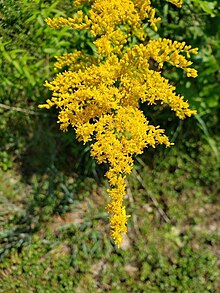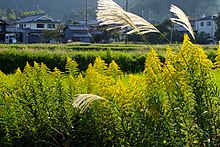Solidago canadensis
| Solidago canadensis | |
|---|---|

| |
| Scientific classification | |
| Kingdom: | Plantae |
| Clade: | Tracheophytes |
| Clade: | Angiosperms |
| Clade: | Eudicots |
| Clade: | Asterids |
| Order: | Asterales |
| Family: | Asteraceae |
| Genus: | Solidago |
| Species: | S. canadensis
|
| Binomial name | |
| Solidago canadensis | |
| Synonyms[1] | |
| |

Solidago canadensis, known as Canada goldenrod or Canadian goldenrod, is an herbaceous perennial plant of the family Asteraceae.[2] It is native to northeastern and north-central North America[3] and often forms colonies of upright growing plants, with many small yellow flowers in a branching inflorescence held above the foliage. It is an invasive plant in other parts of the continent and several areas worldwide, including Europe and Asia. It is grown as an ornamental in flower gardens.[4]
Description
Solidago canadensis is a herbaceous perennial plant with stems that grow 2–4 feet (60–120 centimeters) and sometimes to 6 ft (180 cm) tall. It has a wide distribution with several varieties,[5] which have significant variability.[6] The lanceolate to broadly linear shaped leaves are alternately arranged on the stems.[7] The leaves are 4–6 inches (10–15 centimeters) long and 1 in (2.5 cm) wide. The stems have lines of white hairs, while the undersides of the leaves are pubescent. The leaves are often prominently toothed.[8] The flowers have yellow rays and are arranged into small heads on branched pyramidal shaped inflorescences,[9] flowering occurs from July to October.[10] It has a rhizomatous growth habit, which can produce large colonies of clones.[11] This goldenrod can be found growing on disturbed sites, along dry road sides to moist thickets.[12]
Ecology and distribution
Solidago canadensis is sometimes browsed by deer and is good to fair as food for domestic livestock such as cattle or horses.[13]
It is found in a variety of habitats. It typically is one of the first plants to colonize an area after a disturbance (such as fire) and rarely persists once shrubs and trees become established. It is found in very dry locations and also waterlogged ones.[13]
Canada goldenrod is visited by a wide variety of insects for its pollen and nectar, including bees, wasps, flies, beetles, butterflies, and moths. It is especially strongly favored as a nectar source by bumblebees and paper wasps, such as Polistes parametricus and Polistes fuscatus.[14][15] Aside from wasps, it is also visited frequently by honeybees and some butterflies, such as monarchs.[15]
It can be extremely aggressive and tends to form monocultures and near-monocultures in parts of its native range, such as in southwest Ohio clay loam.[16] It not only seeds a great deal, but also spreads rapidly via running rhizomes. Its root system is very tough, and plants that have been pulled out of the ground prior to freezing and left exposed atop soil have survived winter temperatures down to -26 °C (-14 °F).
Solidago canadensis is winter hardy in USDA hardiness zones 3–9.[17]
Galls
This section needs additional citations for verification. (August 2023) |
Many wasps form parasitic galls inside the stem of goldenrod. There are stem, flower, and bud galls.[18] This species is host to the following insect induced galls:
- Asteromyia carbonifera (Osten Sacken, 1862)
- Asteromyia tumifica (Beutenmuller, 1907)
- Epiblema scudderiana (Clemens, 1860)
- Eurosta solidaginis (Fitch, 1855)
- Eutreta novaeboracensis (Fitch, 1855)
- Gnorimoschema gallaesolidaginis (Fitch, 1855)
- Lasioptera solidaginis Osten Sacken, 1863
- Rhopalomyia capitata Felt, 1908 (spring and summer generation)
- Rhopalomyia solidaginis (Loew, 1862) (spring, summer and autumn generations)
- Schizomyia racemicola (Osten Sacken, 1862)
- Calycomyza solidaginis Kaltenbach, 1869[19]
Invasive species

It is established as an invasive weed in many parts of Europe, Japan and China.[6][20][21][22]
In eastern and southeastern China, particularly the provinces of Zhejiang, Jiangsu, Jiangxi and Shanghai, its invasion has caused widespread concern. Local news reported that the spread of invasive plants including Canada goldenrod has caused the local extinction of 30 native plants in Shanghai, as of 2004.[23] According to the CCTV program Jiaodian Fangtan, it has reduced orange harvests in Ningbo.[24] It is still spreading across China, and sightings have been reported in as far as Yunnan province.[25] Eradication attempts are still underway as of 2021. Confusion with native Solidago species is a concern.[26]
References
- ^ "Solidago canadensis L." Plants of the World Online. Royal Botanic Gardens, Kew. Retrieved 2022-04-08.
- ^ a b USDA, NRCS (n.d.). "Solidago canadensis". The PLANTS Database (plants.usda.gov). Greensboro, North Carolina: National Plant Data Team. Retrieved 18 November 2015.
- ^ a b "Solidago canadensis". County-level distribution map from the North American Plant Atlas (NAPA). Biota of North America Program (BONAP). 2014.
- ^ Rahimi, Omid; Asadi Louie, Nilufar; Salehi, Alireza; Faed Maleki, Firouz (2022-12-17). "Hepatorenal Protective Effects of Hydroalcoholic Extract of Solidago canadensis L. against Paracetamol-Induced Toxicity in Mice". Journal of Toxicology. 2022: 1–11. doi:10.1155/2022/9091605. ISSN 1687-8205. PMC 9789909. PMID 36573135.
- ^ Hong Qian; K. Klinka (1998). Plants of British Columbia: Scientific and Common Names of Vascular Plants, Bryophytes, and Lichens. UBC Press. pp. 440–. ISBN 978-0-7748-0652-7.
- ^ a b c Semple, John C.; Cook, Rachel E. (2006). "Solidago canadensis". In Flora of North America Editorial Committee (ed.). Flora of North America North of Mexico (FNA). Vol. 20. New York and Oxford: Oxford University Press. Retrieved 2022-05-01 – via eFloras.org, Missouri Botanical Garden, St. Louis, MO & Harvard University Herbaria, Cambridge, MA.
- ^ Steven Foster; Christopher Hobbs (2002). A Field Guide to Western Medicinal Plants and Herbs. Houghton Mifflin Harcourt. pp. 131–. ISBN 0-395-83806-1.
- ^ Leonard Adkins (10 August 2006). Wildflowers of the Appalachian Trail. Menasha Ridge Press. pp. 124–. ISBN 978-0-89732-974-3.
- ^ France Royer; Richard Dickinson (December 1996). Wildflowers of Calgary and Southern Alberta. University of Alberta. pp. 118–. ISBN 978-0-88864-283-7.
- ^ Donald D. Cox (1 January 2005). A Naturalist's Guide to Field Plants: An Ecology for Eastern North America. Syracuse University Press. pp. 9–. ISBN 978-0-8156-0780-9.
- ^ David J. Gibson (2015). Methods in Comparative Plant Population Ecology. Oxford University Press. pp. 45–. ISBN 978-0-19-967147-2.
- ^ John C. Kricher; National Audubon Society; National Wildlife Federation (1998). A Field Guide to Eastern Forests, North America. Houghton Mifflin Harcourt. pp. 2–. ISBN 0-395-92895-8.
- ^ a b c Coladonato, Milo (1993). "Solidago canadensis". Fire Effects Information System (FEIS). US Department of Agriculture (USDA), Forest Service (USFS), Rocky Mountain Research Station, Fire Sciences Laboratory. Retrieved 2009-08-24.
- ^ a b Buck, Matthias (26 October 2012). "Taxonomic adventures in the world of paper wasps". Research Blogging. Entomological Society of Canada. Retrieved 9 November 2019.
- ^ a b Blackwell, Will H.; Powell, Martha J. (1981). "Observations on Late Season Pollination of Solidago canadensis L. (Asteraceae) in Southwest Ohio". Castanea. 46 (2): 136–139. ISSN 0008-7475. JSTOR 4033045. Retrieved 2021-10-21.
- ^ Werner, Patricia A.; Gross, Ronald S.; Bradbury, Ian K. (1980-10-01). "The Biology of Canadian Weeds 45. Solidago canadensis L." Canadian Journal of Plant Science. 60 (4): 1393–1409. doi:10.4141/cjps80-194. ISSN 0008-4220. Retrieved 2021-10-22.
- ^ Maureen Heffernan (1 February 2010). Native Plants for Your Maine Garden. Down East Books. pp. 213–. ISBN 978-0-89272-900-5.
- ^ Weis, A. E., & Abrahamson, W. G. (1986). Evolution of host-plant manipulation by gall makers: ecological and genetic factors in the Solidago-Eurosta system. The American Naturalist, 127(5), 681-695.
- ^ Kaltenbach, J.H. (1869). "Die deutschen Phytophagen aus der Klasse der Insekten [concl.]". Verh. Naturh. Ver. Preuss. Rheinl. 26 (3, 6): 106–224.
- ^ a b Altervista Flora Italiana, Verga d'oro del Canadà, Solidago canadensis L. photos, European distribution map
- ^ a b Chen, Yilin; Semple, John C. "Solidago canadensis". Flora of China – via eFloras.org, Missouri Botanical Garden, St. Louis, MO & Harvard University Herbaria, Cambridge, MA.
- ^ a b Atlas of Living Australia
- ^ "江苏清剿被称为植物杀手的外来生物一枝黄花" [Jiangsu tackles Goldenrod, the exotic plant-killer]. 江南时报 [Jiangnan Times] (in Chinese). 2004. Archived from the original on 2006-06-24.
- ^ CCTV. "焦点访谈:疯长的一枝黄花" [Focus: Goldenrods going wild] (in Chinese). Archived from the original on 2004-12-17.
- ^ a b Blanchan, Neltje (2005). Wild Flowers Worth Knowing. Project Gutenberg Literary Archive Foundation.
- ^ SUN, hai. "可怕!多地围剿"恶魔之花",看到这种花请立刻上报" [Scary! Localities fighting the "Devil's Flower", report on sight]. new.qq.com (in Chinese). Retrieved 25 October 2022.
- ^ Hassler, Frank (21 August 2014). "Canada Goldenrod" (PDF). goodoak.com. Good Oak Ecological Services. Retrieved 9 November 2019.
- ^ "Complementary and Alternative Medicine - Penn State Hershey Medical Center - Goldenrod".
- ^ Jie Li, Li Pan, Joshua N. Fletcher, Wei Lv, Ye Deng, Michael A. Vincent, Jay P. Slack, T. Scott McCluskey, Zhonghua Jia, Mark Cushman, and A. Douglas Kinghorn (2014). Journal of Natural Products 2014 77 (7), 1739-1743. DOI: 10.1021/np5001413.
External links
- Jepson Manual Treatment: Solidago canadensis
- United States Geological Survey: Solidago canadensis
- Profile: Canada Goldenrod (Solidago canadensis) Photos, Drawings, Text. (Wild Plants of Winnipeg from Nature Manitoba)
- Pages using eFloras template without volume
- CS1 Chinese-language sources (zh)
- Articles with short description
- Short description matches Wikidata
- NatureServe secure species
- Articles with 'species' microformats
- Articles needing additional references from August 2023
- All articles needing additional references
- Commons category link is on Wikidata
- Taxonbars with 40–44 taxon IDs
- Solidago
- Flora of Northern America
- Plants described in 1753
- Taxa named by Carl Linnaeus
